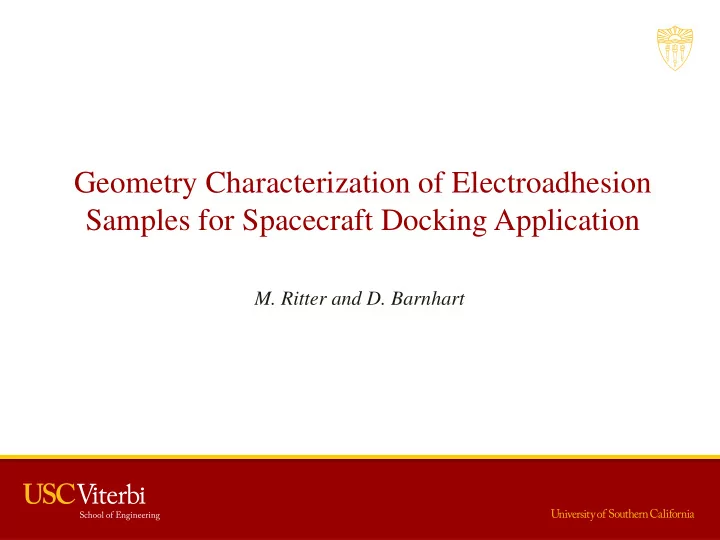

Geometry Characterization of Electroadhesion Samples for Spacecraft Docking Application M. Ritter and D. Barnhart
Table of Contents 1. Introduction 2. Experiment 3. Results and Discussion 4. Conclusions 5. Further Investigation 2 of 25
Table of Contents 1. Introduction 2. Experiment 3. Results and Discussion 4. Conclusions 5. Further Investigation 2 of 25
Motivation Docking mechanisms are essential in space missions. Determining a low-risk, low-cost alternative to past docking techniques advances the frontier of space technology. ssg.dii.unipd.it Introduction 3 of 25
Research Objective Study maximum shear forces of Electroadhesion samples composed of space-rated materials on substrates, test geometries of samples with air- bearing platforms as docking mechanisms, and propose a metric for capturing. NASA Introduction 4 of 25
Applications of Electroadhesion Industrial Military Biomedical SRI International SRI International US Patent: Electroadhesive Medical Devices Consumer Space Introduction 5 of 25
Electroadhesion Technology Cross-Sectional View: Introduction 6 of 25
Electroadhesion Technology Cross-Sectional View: Top View: Introduction 6 of 25
Electroadhesion Technology Cross-Sectional View: Top View: Governing Equations: Dielectric Constant of Vacuum Dielectric Constant of Kapton Applied Voltage Kapton Thickness Coefficient of Static Friction Introduction 6 of 25
Table of Contents 1. Introduction 2. Experiment 3. Results and Discussion 4. Conclusions 5. Further Investigation 7 of 25
Materials and Method Measure maximum shear forces of Electroadhesion samples at • variable input voltages (1 kV – 5 kV) Configure samples into proposed geometries and test with air- • bearing platforms Materials • Electrode Material • Heavy Duty Aluminum Foil • Substrate Materials • Anodized Aluminum • Bare Aluminum • Aluminized Mylar • Clamping (Insulating) Material • Kapton • Experiment 8 of 25
Static Response Figure 1: Experimental setup of electroadhesion sample attached to substrate with measured shear force. Experiment 9 of 25
Dynamic Application (1) Flat Plate Cubesat • Flat Spacecraft • Side (2) Concave Cylinder Cylindrical • Spacecraft Torque Mitigation • (3) 4-Arm Clamp Variety of shapes • on Spacecraft Other small objects • Experiment Figure 2: Geometry configurations of samples. 10 of 25
Dynamic Application Figure 3: Experimental setup of air bearing platform with attached substrate and Experiment electroadhesion device of geometry (3). 11 of 25
Table of Contents 1. Introduction 2. Experiment 3. Results and Discussion 4. Conclusions 5. Further Investigation 12 of 25
Static Response Results and Discussion 13 of 25
Static Response Aluminized Mylar Efficiently conformed to • electroadhesion sample Largest shear pressure • Aluminum (Bare and Anodized) Rigid substrates • Air pockets between sample • and substrate Figure 4: Static shear pressure. Results and Discussion 14 of 25
Constructed Geometries (2) (1) Figure 5: Clamp Geometry (1) (left) and Geometry (2) (right) of electroadhesion samples. Results and Discussion 15 of 25
Constructed Geometries (3) Figure 6: Clamp Geometry (3) of electroadhesion samples. Results and Discussion 16 of 25
Dynamic Application Figure 7: Air-bearing platform isometric and side views. Results and Discussion 17 of 25
Dynamic Application Figure 8: Comparison of time for electroadhesion Results and Discussion geometry to stop movement. 18 of 25
Proposed Metric for Capturing Results and Discussion 19 of 25
Table of Contents 1. Introduction 2. Experiment 3. Results and Discussion 4. Conclusions 5. Further Investigation 20 of 25
Summary of Results Superior geometry is dependent on scenario • Lag of material from hard structure determined best docking • scenarios Implies soft structures are optimal • Flexible aluminized Mylar material produced greatest shear • pressure with electroadhesion sample Linear relationship between initial approach velocity, residual • motion, and surface area of contact A metric is proposed to determine the stop time of initial and • residual motion dependent on electroadhesion geometry and contact surface area Conclusions 21 of 25
Table of Contents 1. Introduction 2. Experiment 3. Results and Discussion 4. Conclusions 5. Further Investigation 22 of 25
Future Research Varying Insulating • Material Manufactured • electroadhesion samples to acquire greater shear forces (NASA-JPL) Additional sample • geometries Control algorithms for • docking with claw NASA geometry Further Investigation 23 of 25
References 24 of 25
This research was supported by the Space Engineering Research Center at the Information Sciences Institute with the Viterbi School of Engineering at the University of Southern California. 25 of 25
Recommend
More recommend